what contributions did aristotle make to the understanding of earths position in the solar system?
Planetary Movement: The History of an Idea That Launched the Scientific Revolution
July 7, 2009
In the black dome of dark, the stars seem fixed in their patterns. They rotate through the sky over the seasons so unchangingly that most cultures take used the presence of one or some other constellation to tell time. The planets, withal, are dissimilar, puzzling. They glide slowly and seemingly erratically across the heaven. Attempts to explain why the planets motion as they practise led to modern scientific discipline's understanding of gravity and motility.
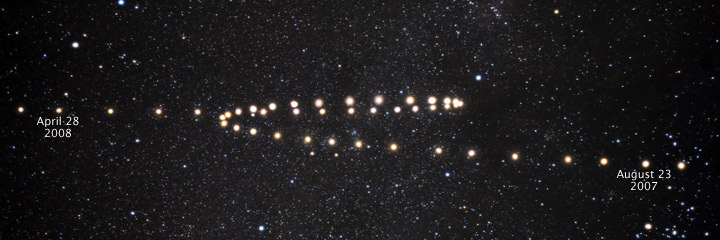
Many aboriginal and medieval cultures believed the stars and the planets rotated around a fixed Earth. The complex motions of the planets—which sometimes move backwards beyond the heaven (retrograde motion, shown in the photo)—led Renaissance astronomers to question this geocentric theory. These astronomers discovered the laws of orbital mechanics, transforming natural philosophy into the practice of science. (Photo ©2007–08 Tunç Tezel.)
Evolution of an Idea
"Nosotros circumduct effectually the Sun similar any other planet." —Nicolaus Copernicus
"Of all discoveries and opinions, none may accept exerted a greater event on the human spirit than the doctrine of Copernicus. The world has scarcely go known every bit round and complete in itself when it was asked to waive the tremendous privilege of being the heart of the universe." —Johann Wolfgang von Goethe
The ancient Greek philosophers, whose ideas shaped the worldview of Western Culture leading upward to the Scientific Revolution in the sixteenth century, had conflicting theories almost why the planets moved across the sky. One camp thought that the planets orbited around the Sun, merely Aristotle, whose ideas prevailed, believed that the planets and the Sun orbited World. He saw no sign that the Earth was in motion: no perpetual wind blew over the surface of the Earth, and a brawl thrown straight upwardly into the air doesn't country behind the thrower, every bit Aristotle assumed information technology would if the Earth were moving. For Aristotle, this meant that the World had to exist stationary, and the planets, the Sun, and the stock-still dome of stars rotated around Earth.
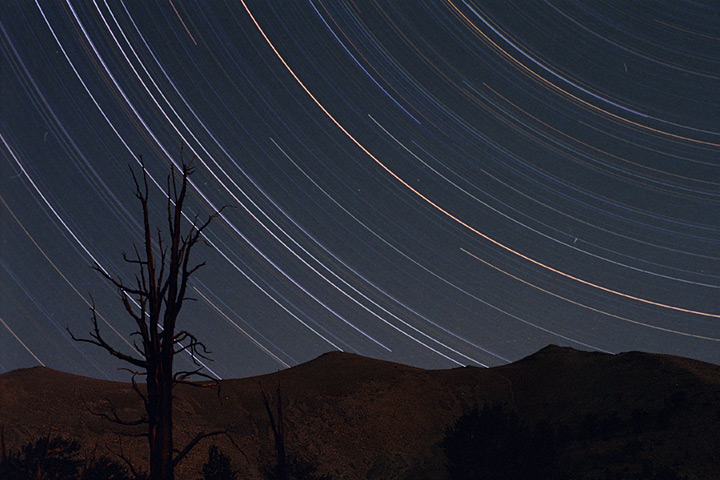
A long-exposure photograph reveals the apparent rotation of the stars around the Globe. (Photograph ©1992 Philip Greenspun.)
For nearly 1,000 years, Aristotle's view of a stationary Earth at the center of a revolving universe dominated natural philosophy, the name that scholars of the time used for studies of the concrete earth. A geocentric worldview became engrained in Christian theology, making information technology a doctrine of religion equally much equally natural philosophy. Despite that, it was a priest who brought back the idea that the Earth moves around the Dominicus.
In 1515, a Polish priest named Nicolaus Copernicus proposed that the Earth was a planet like Venus or Saturn, and that all planets circled the Sun. Afraid of criticism (some scholars retrieve Copernicus was more concerned most scientific shortcomings of his theories than he was about the Church's disapproval), he did not publish his theory until 1543, shortly before his death. The theory gathered few followers, and for a fourth dimension, some of those who did requite credence to the idea faced charges of heresy. Italian scientist Giordano Bruno was burned at the stake for teaching, among other heretical ideas, Copernicus' heliocentric view of the Universe.

In 1543, Nicolaus Copernicus detailed his radical theory of the Universe in which the Globe, along with the other planets, rotated around the Dominicus. His theory took more than a century to go widely accepted. [Adapted from Nicolaus Copernicus, 1543, De revolutionibus orbium coelestium ("On the Revolutions of the Heavenly Spheres.")]
Simply the evidence for a heliocentric solar system gradually mounted. When Galileo pointed his telescope into the night sky in 1610, he saw for the first time in human being history that moons orbited Jupiter. If Aristotle were right well-nigh all things orbiting Earth, then these moons could not exist. Galileo also observed the phases of Venus, which proved that the planet orbits the Sun. While Galileo did not share Bruno's fate, he was tried for heresy under the Roman Inquisition and placed nether firm arrest for life.

Galileo discovered evidence to support Copernicus' heliocentric theory when he observed four moons in orbit effectually Jupiter. Beginning on January 7, 1610, he mapped nightly the position of the 4 "Medicean stars" (afterwards renamed the Galilean moons). Over time Galileo deduced that the "stars" were in fact moons in orbit effectually Jupiter. [Adjusted from Galileo Galilei, 1610, Sidereus Nuncius ("The Starry Messenger.")]
At about the same time, German mathematician Johannes Kepler was publishing a serial of laws that describe the orbits of the planets around the Lord's day. Still in utilise today, the mathematical equations provided accurate predictions of the planets' movement under Copernican theory. In 1687, Isaac Newton put the final nail in the coffin for the Aristotelian, geocentric view of the Universe. Building on Kepler's laws, Newton explained why the planets moved every bit they did around the Sun and he gave the force that kept them in check a name: gravity.
The Science: Orbital Mechanics
Kepler'southward Laws of Planetary Movement
While Copernicus rightly observed that the planets revolve around the Sun, it was Kepler who correctly defined their orbits. At the age of 27, Kepler became the assistant of a wealthy astronomer, Tycho Brahe, who asked him to define the orbit of Mars. Brahe had collected a lifetime of astronomical observations, which, on his death, passed into Kepler'south hands. (Brahe, who had his own World-centered model of the Universe, withheld the majority of his observations from Kepler at least in part because he did not want Kepler to apply them to evidence Copernican theory correct.) Using these observations, Kepler found that the orbits of the planets followed iii laws.
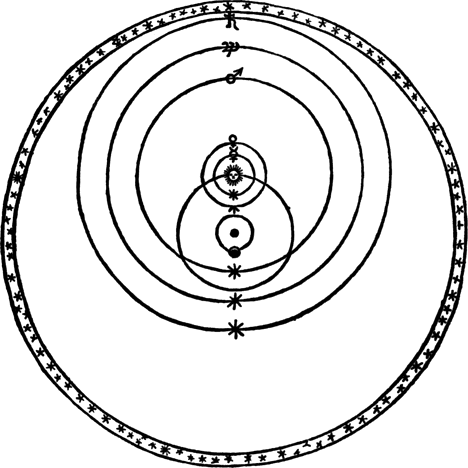
Brahe believed in a model of the Universe with the Sun (rayed disk) orbiting the Earth (black dot), simply the other planets (symbols) orbiting the Dominicus. In an attempt to prove his theory, Brahe compiled extensive astronomical records, which Kepler somewhen used to prove heliocentrism and to calculate the orbital laws. [Adapted from Tycho Brahe, Astronomiae instauratae progymnasmata ("Introductory exercises toward the restoration of astronomy.")]
Like many philosophers of his era, Kepler had a mystical belief that the circle was the Universe's perfect shape, and that as a manifestation of Divine order, the planets' orbits must be round. For many years, he struggled to make Brahe's observations of the motions of Mars match up with a circular orbit.
Eventually, withal, Kepler noticed that an imaginary line drawn from a planet to the Sun swept out an equal expanse of space in equal times, regardless of where the planet was in its orbit. If you draw a triangle out from the Sun to a planet's position at 1 point in time and its position at a fixed fourth dimension subsequently—say, v hours, or two days—the area of that triangle is always the same, anywhere in the orbit. For all these triangles to have the same area, the planet must move more quickly when information technology is about the Sun, but more slowly when information technology is uttermost from the Sun.
This discovery (which became Kepler's 2nd constabulary of orbital movement) led to the realization of what became Kepler's first law: that the planets motion in an ellipse (a squashed circumvolve) with the Dominicus at one focus point, offset from the middle.
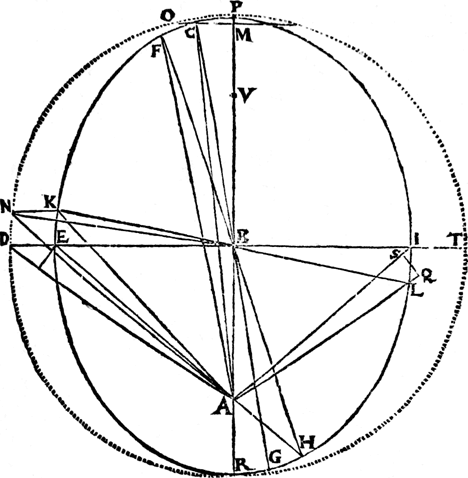
Through Brahe's astronomical measurements and Kepler'southward own drawings of the geometrical human relationship between the Sun and Mars in diverse parts of the planet's orbit, Kepler discovered that planets moved faster when they were closer to the Dominicus. From this realization, he concluded that the orbit of Mars was elliptical, non round. [Adjusted from Johannes Kepler, Image astronomia Copernicanae ("Image of Copernican Astronomy.")]
Kepler's 3rd police shows that in that location is a precise mathematical human relationship betwixt a planet'due south distance from the Sun and the amount of time it takes revolve around the Sun. Information technology was this law that inspired Newton, who came upwards with three laws of his ain to explain why the planets motility equally they do.
Newton's Laws of Motion
If Kepler'due south laws define the move of the planets, Newton'due south laws ascertain motility. Thinking on Kepler'due south laws, Newton realized that all motion, whether it was the orbit of the Moon around the Earth or an apple falling from a tree, followed the aforementioned basic principles. "To the same natural furnishings," he wrote, "we must, as far as possible, assign the aforementioned causes." Previous Aristotelian thinking, physicist Stephen Hawking has written, assigned different causes to unlike types of motion. Past unifying all move, Newton shifted the scientific perspective to a search for large, unifying patterns in nature. Newton outlined his laws in Philosophiae Naturalis Principia Mathematica ("Mathematical Principles of Natural Philosophy,") published in 1687.
Law I. Every torso perseveres in its state of rest, or of uniform movement in a correct line, unless it is compelled to change that state by forces impressed theron.
In essence, a moving object won't modify speed or direction, nor will a still object outset moving, unless some outside force acts on it. The law is regularly summed upwards in one give-and-take: inertia.
Law II. The amending of motility is ever proportional to the motive forcefulness impressed; and is fabricated in the management of the right line in which that force is impressed.
Newton'south second law is nigh recognizable in its mathematical class, the iconic equation: F=ma. The strength of the force (F) is defined by how much it changes the move (acceleration, a) of an object with some mass (m).
Law III. To every activeness there is always opposed an equal reaction: or the mutual deportment of two bodies upon each other are always equal, and directed to contrary parts.
As Newton himself described: "If you press a stone with your finger, the finger is also pressed by the stone."
Gravity
Inside the pages of Principia, Newton also presented his constabulary of universal gravitation as a instance report of his laws of motion. All matter exerts a force, which he called gravity, that pulls all other thing towards its center. The force of the force depends on the mass of the object: the Lord's day has more gravity than Globe, which in plow has more gravity than an apple. Besides, the force weakens with distance. Objects far from the Sunday won't exist influenced past its gravity.
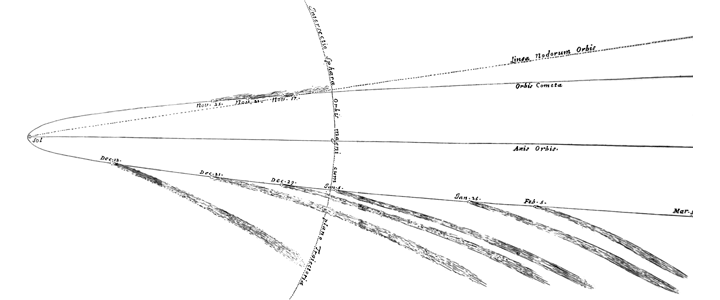
Isaac Newton demonstrated his universal law of gravitation past showing that a comet visible during 1680 and 1681 followed the path of a parabola. [Adjusted from Isaac Newton, 1687. Philosophiae Naturalis Principia Mathematica ("Mathematical Principles of Natural Philosophy.")]
Newton's laws of motion and gravity explained Earth's almanac journey around the Sun. Earth would motility straight frontwards through the universe, simply the Sun exerts a constant pull on our planet. This strength bends World's path toward the Sun, pulling the planet into an elliptical (well-nigh circular) orbit. His theories as well made it possible to explain and predict the tides. The rising and fall of body of water water levels are created by the gravitational pull of the Moon as it orbits Globe.
Einstein and Relativity
The ideas outlined in Newton'south laws of motility and universal gravitation stood unchallenged for nigh 220 years until Albert Einstein presented his theory of special relativity in 1905. Newton's theory depended on the assumption that mass, time, and distance are constant regardless of where you measure them.
The theory of relativity treats time, space, and mass as fluid things, defined by an observer's frame of reference. All of united states of america moving through the universe on the Earth are in a single frame of reference, but an astronaut in a fast-moving spaceship would be in a different reference frame.
Inside a unmarried frame of reference, the laws of classical physics, including Newton's laws, concur true. But Newton'south laws can't explicate the differences in motion, mass, distance, and time that result when objects are observed from two very different frames of reference. To draw movement in these situations, scientists must rely on Einstein's theory of relativity.
At ho-hum speeds and at large scales, however, the differences in time, length, and mass predicted by relativity are pocket-size plenty that they appear to exist constant, and Newton'due south laws still work. In general, few things are moving at speeds fast enough for us to find relativity. For big, slow-moving satellites, Newton's laws still define orbits. Nosotros can still use them to launch Globe-observing satellites and predict their movement. We can use them to attain the Moon, Mars, and other places beyond Earth. For this reason, many scientists run into Einstein's laws of general and special relativity not as a replacement of Newton'southward laws of motion and universal gravitation, but as the full culmination of his idea.
-
References
- Air Academy. (2003, August). Orbital Mechanics. Space Primer. Accessed May 22, 2009.
- Blitzer, L. (1971, Baronial). Satellite orbit paradox: A general view. American Periodical of Physics, 39, 882-886.
- Gleick, J. (2003). Isaac Newton. New York: Vintage Books.
- Gribbon, J. (2008). The Scientists: A History of Science Told Through the Lives of Its Greatest Inventors. New York: Random House.
- Hawking, S. (2004). The Illustrated on the Shoulders of Giants. Philadelphia: Running Press.
- Iannotta, B., and Malik, T. (2009, Feb xi). U.South. satellite destroyed in space collision. Accessed May 22, 2009.
- Komoma. GPS Satellite Orbits. Accessed May 22, 2009.
- Serway, R.A. (1992). Physics for Scientists and Engineers, 3rd ed. Philadelphia: Saunders College Publishing and Harcourt Brace College Publishers.
- Wolfe, J., and Hatsidimitris, Yard. (2005). Einstein Lite. University of New South Wales. Accessed June eleven, 2009.
Source: https://www.earthobservatory.nasa.gov/features/OrbitsHistory
0 Response to "what contributions did aristotle make to the understanding of earths position in the solar system?"
Post a Comment